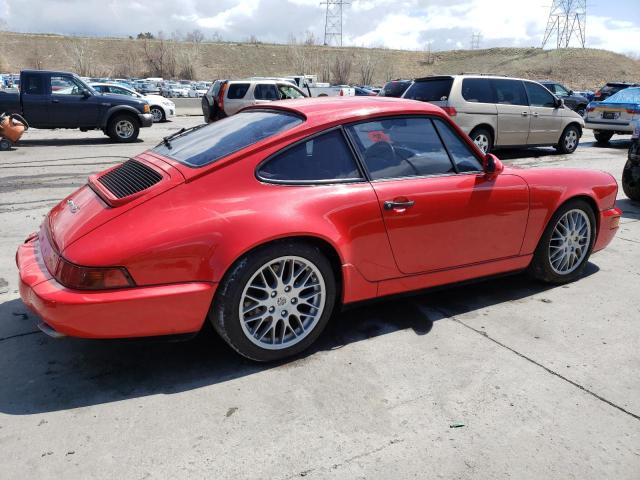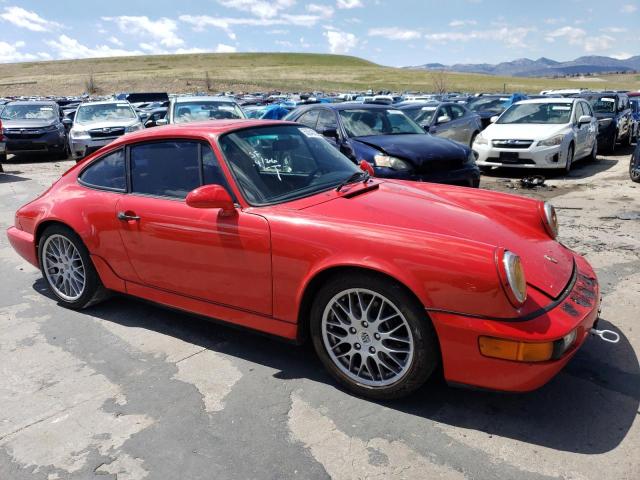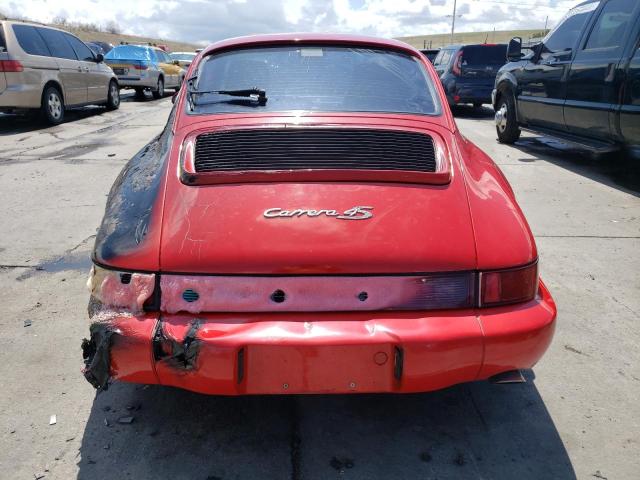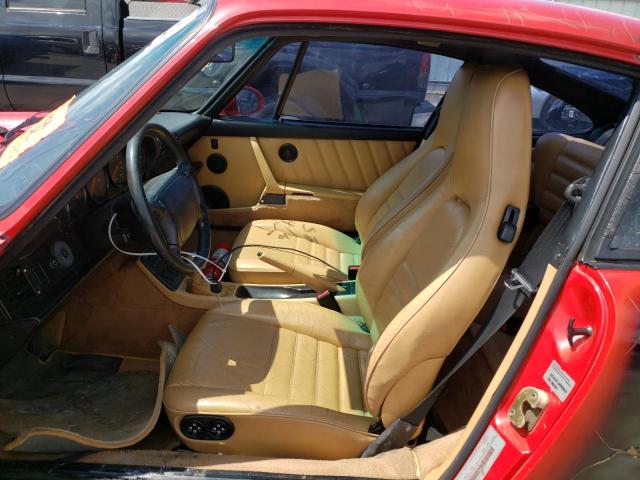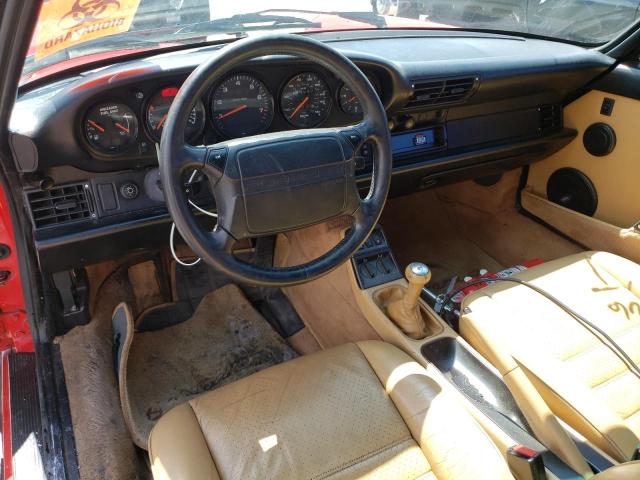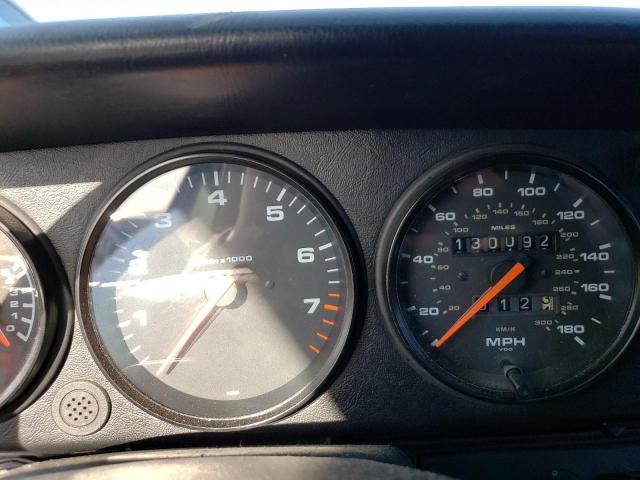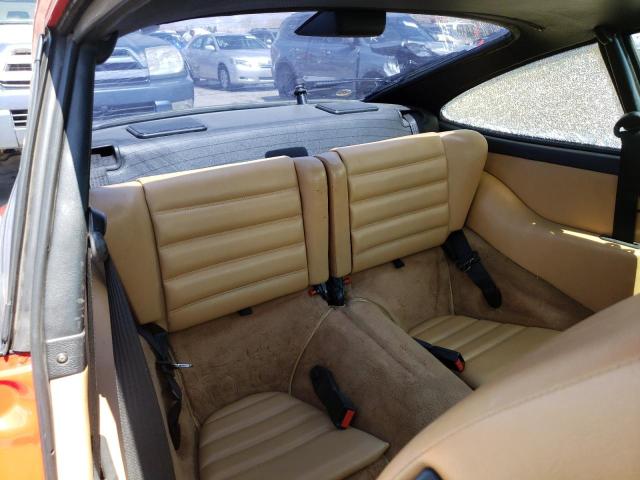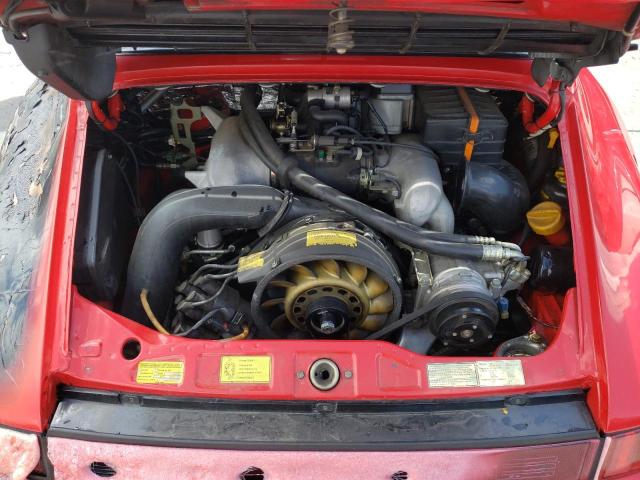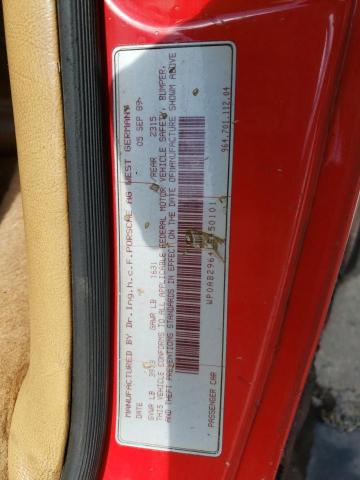1990 PORSCHE 911 | WP0AB2964LS450101
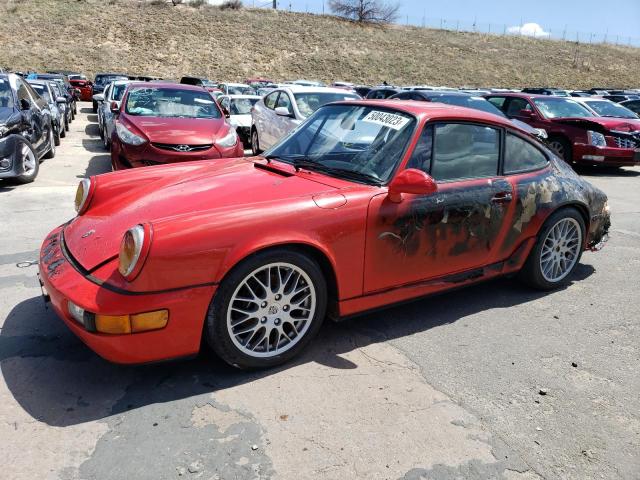 ❯
❯
Specifications
4
~$132,000
Engine: 3.6L turbocharged flat-six
Torque: 520 Nm
0–100 km/h: ~4.2 s
The 964-generation Porsche 911 brought major technological updates to the iconic 911 platform while preserving its classic air-cooled character. The most potent variant was the 911 Turbo 3.6, introduced in 1993, which featured a 3.6L turbocharged flat-six producing 360 hp and 520 Nm of torque. This allowed for a 0–100 km/h sprint in 4.2 seconds, placing it among the fastest production cars of its time.
The earlier 964 Turbo 3.3 (1990–1992) used a carryover 3.3L engine from the 930, delivering 320 hp with more turbo lag but still blistering performance. All Turbo models featured rear-wheel drive, upgraded brakes, wider rear fenders, and a signature “tea tray” rear spoiler.
Even non-Turbo 964s offered serious driving performance. The Carrera 2 and Carrera 4 introduced a new 3.6L naturally aspirated flat-six, producing 250 hp, paired with a 5-speed manual or Tiptronic transmission. The Carrera 4 introduced the first all-wheel-drive 911, adding composure in slippery conditions and marking a technological leap. Meanwhile, the lightweight 911 Carrera RS (Europe-only) offered a track-focused experience with stiffer suspension, reduced weight, and a close-ratio gearbox — emphasizing the raw, analog nature of the 964 platform.
With its mix of classic rear-engine dynamics, updated suspension (coil springs replacing torsion bars), power steering, and ABS, the 964 retained the feel of earlier 911s while making it faster, more stable, and more accessible than ever before.
Body Styles
The Porsche 911 (964) was offered in coupé, targa, and cabriolet forms. The coupé featured the iconic fastback profile, with the engine mounted behind the rear axle, a low roofline, upright windshield, and round headlights integrated into slightly flared fenders. While visually similar to the earlier G-series, nearly 85% of the 964 was new underneath, and its proportions were subtly more muscular — especially in Turbo and RS trims with wider rear tracks and integrated bumpers.
The Targa retained the classic brushed metal roll hoop and removable roof panel, offering open-air driving with added structural rigidity. The Cabriolet version featured a fully power-operated soft top and reinforced chassis, sacrificing some of the coupe’s rigidity for convertible freedom. All variants had minimal overhangs, a distinct tail-heavy stance, and — in Turbo models — a large fixed spoiler integrated with the engine cover.
Though compact by modern standards (4.2 m long), the 964’s stance was aggressive and unmistakable, with a rear-biased weight distribution, prominent Fuchs-style wheels (early models), and timeless surfacing that made it the last truly “classic-shaped” 911.
Model Name Meaning (Manufacturer)
The “911” designation is Porsche’s flagship sports car name, introduced in the 1960s. The internal codename “964” refers specifically to the 1989–1994 generation of the 911, which modernized the platform with new engineering while maintaining the air-cooled flat-six engine and rear-engine layout.
Model Name Meaning (Languages)
“911” is universally recognized as Porsche’s performance icon. The number carries immense brand equity, while “Turbo,” “Carrera,” and “RS” have taken on legendary status. In this era, “Turbo” meant elite performance, “Carrera” represented purist driving, and “RS” (Rennsport) stood for track-oriented precision — each nameplate evoking distinct yet equally coveted meanings among enthusiasts.
Body & Interior Colors and Rims
The Porsche 911 (964) of 1989–1993 combined classic 911 proportions with modernized aerodynamics and technology, and this evolution was echoed in a bold yet timeless selection of exterior and interior colors, along with now-iconic wheel designs. The body was offered in a wide palette that included Guards Red, Grand Prix White, Slate Grey Metallic, Midnight Blue, and Black, as well as more vivid choices such as Amazon Green, Amethyst Pearl, Maritime Blue, Raspberry Red, and Signal Green. Many of these shades were standard or special-order options, while the Porsche Paint to Sample (PTS) program allowed buyers to select unique finishes that made their cars one-of-a-kind.
The 964 generation introduced integrated bumpers, a retractable rear spoiler, and smoother side surfacing, which highlighted paint quality and reflected light differently than earlier 911s. Turbo models and the Carrera RS featured wider rear fenders, model-specific rear wings, and distinct paint-matched trim options. Targa and Cabriolet variants offered contrasting or matching roof components and fabric colors, further adding to visual personalization.
Inside, the 964 featured a blend of period-accurate analog charm and updated ergonomics. Standard interior upholstery was available in Black, Marble Grey, Cashmere Beige, and Dark Blue, with optional leathers in Cobalt Blue, Classic Grey, Burgundy, and Rubicon Grey. High-spec models and Porsche Exclusive builds could be ordered with full leather dashboards, two-tone seat treatments, or custom piping and stitching. Seat options ranged from comfort touring seats to sport bucket seats and Recaro shells (on RS and Clubsport trims), with various padding levels and materials including leatherette, Nappa leather, and cloth with tri-color Porsche script or houndstooth inserts.
Trim elements included black or body-colored plastics, brushed aluminum, and wood or carbon-look inlays for select markets or through custom orders. The air-cooled cabin layout remained classic, with five round analog gauges, a simple center console, and rounded dashboard contours, preserving the 911 identity while integrating features like ABS, climate control, and airbags in later years.
Wheels were a defining aesthetic and functional component of the 964. Early Carrera models came with 15- or 16-inch Design 90 alloy wheels, finished in Silver, White, or Anthracite, depending on the body color. Optional Cup wheels (introduced later) and Turbo-specific Speedline wheels added more aggressive flair. The Carrera RS featured lightweight magnesium Cup wheels, while Turbo models wore 17-inch staggered-width alloys, sometimes with polished lips or center caps bearing the Porsche crest.
Tire sizes were tailored to each model's balance and power delivery. Narrower Carrera 2 models used a square stance, while Turbo and RS variants received wider rear tires for improved grip and handling. Behind the wheels, ventilated disc brakes with painted calipers — typically in black or silver — provided period-correct stopping power.
The 964’s stance, paintwork, and iconic wheels contributed to one of the most revered visual profiles in Porsche history — blending early air-cooled character with modern performance elegance.
Top Expensive Options
- Limited-Slip Differential (standard on RS, optional on Carrera): $1,500
- Air Conditioning with Automatic Climate Control: $2,000
- Full Leather Interior with Contrast Stitching: $3,200
- Heated Sports Seats with Electric Adjustment: $1,700
- Sunroof (Coupé only): $1,300
- Tiptronic Automatic Transmission (Carrera 2 only): $2,400
- Rear Wiper and Headlight Washers Package: $500
- Sound System Upgrade with Blaupunkt Radio: $850
- Touring Package (RS): ~$4,000
- Porsche Exclusive Paint-to-Sample Option: $3,500+
vs Competitors
The 964 911 competed with the Ferrari 348, Chevrolet Corvette C4 ZR-1, Nissan 300ZX Twin Turbo, and Honda NSX. While others boasted higher top speeds or flashier styling, the 911 offered heritage, daily usability, and unrivaled rear-engine dynamics. The Turbo 3.6, in particular, was a supercar slayer — quicker than a Ferrari Testarossa, more usable than an F40, and rarer than both.
The 964 stood out for its blend of engineering purity, driver feedback, and timeless design. The Carrera 4 introduced AWD to the 911 platform, enhancing wet-weather stability. The RS brought race-car rawness to the street. The Turbo remained the king of the Autobahn, with ferocious acceleration, boosted punch, and unmistakable road presence.
Fun Fact
Only 1,437 units of the 964 Turbo 3.6 were produced globally, making it one of the rarest and most collectible air-cooled 911s. It marked the final chapter of single-turbo rear-wheel-drive 911s before the shift to twin-turbo AWD in the 993 Turbo. Because of this, the 964 Turbo 3.6 has become a $300,000+ collector’s icon, revered for its analog ferocity and unmistakable silhouette.
Lot Details
-
Sale Date17/Jul/2023
-
Lot Number50043023
-
Sale document
-
Location
-
Odometer130,092 miles
-
Primary Damage:BURN
-
Secondary DamageMINOR DENT/SCRATCHES
-
Fuel
-
Engine Type3.6L 6
-
Transmission
-
Drive Type
-
Color
Final Bid Porsche 911 (1990)
$47,000
$54,750
$62,500
Specifications
4
~$132,000
Torque:
0–100 km/h:
The 964-generation Porsche 911 brought major technological updates to the iconic 911 platform while preserving its classic air-cooled character. The most potent variant was the 911 Turbo 3.6, introduced in 1993, which featured a 3.6L turbocharged flat-six producing 360 hp and 520 Nm of torque. This allowed for a 0–100 km/h sprint in 4.2 seconds, placing it among the fastest production cars of its time.
The earlier 964 Turbo 3.3 (1990–1992) used a carryover 3.3L engine from the 930, delivering 320 hp with more turbo lag but still blistering performance. All Turbo models featured rear-wheel drive, upgraded brakes, wider rear fenders, and a signature “tea tray” rear spoiler.
Even non-Turbo 964s offered serious driving performance. The Carrera 2 and Carrera 4 introduced a new 3.6L naturally aspirated flat-six, producing 250 hp, paired with a 5-speed manual or Tiptronic transmission. The Carrera 4 introduced the first all-wheel-drive 911, adding composure in slippery conditions and marking a technological leap. Meanwhile, the lightweight 911 Carrera RS (Europe-only) offered a track-focused experience with stiffer suspension, reduced weight, and a close-ratio gearbox — emphasizing the raw, analog nature of the 964 platform.
With its mix of classic rear-engine dynamics, updated suspension (coil springs replacing torsion bars), power steering, and ABS, the 964 retained the feel of earlier 911s while making it faster, more stable, and more accessible than ever before.
Body Styles
The Porsche 911 (964) was offered in coupé, targa, and cabriolet forms. The coupé featured the iconic fastback profile, with the engine mounted behind the rear axle, a low roofline, upright windshield, and round headlights integrated into slightly flared fenders. While visually similar to the earlier G-series, nearly 85% of the 964 was new underneath, and its proportions were subtly more muscular — especially in Turbo and RS trims with wider rear tracks and integrated bumpers.
The Targa retained the classic brushed metal roll hoop and removable roof panel, offering open-air driving with added structural rigidity. The Cabriolet version featured a fully power-operated soft top and reinforced chassis, sacrificing some of the coupe’s rigidity for convertible freedom. All variants had minimal overhangs, a distinct tail-heavy stance, and — in Turbo models — a large fixed spoiler integrated with the engine cover.
Though compact by modern standards (4.2 m long), the 964’s stance was aggressive and unmistakable, with a rear-biased weight distribution, prominent Fuchs-style wheels (early models), and timeless surfacing that made it the last truly “classic-shaped” 911.
Model Name Meaning (Manufacturer)
The “911” designation is Porsche’s flagship sports car name, introduced in the 1960s. The internal codename “964” refers specifically to the 1989–1994 generation of the 911, which modernized the platform with new engineering while maintaining the air-cooled flat-six engine and rear-engine layout.
Model Name Meaning (Languages)
“911” is universally recognized as Porsche’s performance icon. The number carries immense brand equity, while “Turbo,” “Carrera,” and “RS” have taken on legendary status. In this era, “Turbo” meant elite performance, “Carrera” represented purist driving, and “RS” (Rennsport) stood for track-oriented precision — each nameplate evoking distinct yet equally coveted meanings among enthusiasts.
Body & Interior Colors and Rims
The Porsche 911 (964) of 1989–1993 combined classic 911 proportions with modernized aerodynamics and technology, and this evolution was echoed in a bold yet timeless selection of exterior and interior colors, along with now-iconic wheel designs. The body was offered in a wide palette that included Guards Red, Grand Prix White, Slate Grey Metallic, Midnight Blue, and Black, as well as more vivid choices such as Amazon Green, Amethyst Pearl, Maritime Blue, Raspberry Red, and Signal Green. Many of these shades were standard or special-order options, while the Porsche Paint to Sample (PTS) program allowed buyers to select unique finishes that made their cars one-of-a-kind.
The 964 generation introduced integrated bumpers, a retractable rear spoiler, and smoother side surfacing, which highlighted paint quality and reflected light differently than earlier 911s. Turbo models and the Carrera RS featured wider rear fenders, model-specific rear wings, and distinct paint-matched trim options. Targa and Cabriolet variants offered contrasting or matching roof components and fabric colors, further adding to visual personalization.
Inside, the 964 featured a blend of period-accurate analog charm and updated ergonomics. Standard interior upholstery was available in Black, Marble Grey, Cashmere Beige, and Dark Blue, with optional leathers in Cobalt Blue, Classic Grey, Burgundy, and Rubicon Grey. High-spec models and Porsche Exclusive builds could be ordered with full leather dashboards, two-tone seat treatments, or custom piping and stitching. Seat options ranged from comfort touring seats to sport bucket seats and Recaro shells (on RS and Clubsport trims), with various padding levels and materials including leatherette, Nappa leather, and cloth with tri-color Porsche script or houndstooth inserts.
Trim elements included black or body-colored plastics, brushed aluminum, and wood or carbon-look inlays for select markets or through custom orders. The air-cooled cabin layout remained classic, with five round analog gauges, a simple center console, and rounded dashboard contours, preserving the 911 identity while integrating features like ABS, climate control, and airbags in later years.
Wheels were a defining aesthetic and functional component of the 964. Early Carrera models came with 15- or 16-inch Design 90 alloy wheels, finished in Silver, White, or Anthracite, depending on the body color. Optional Cup wheels (introduced later) and Turbo-specific Speedline wheels added more aggressive flair. The Carrera RS featured lightweight magnesium Cup wheels, while Turbo models wore 17-inch staggered-width alloys, sometimes with polished lips or center caps bearing the Porsche crest.
Tire sizes were tailored to each model's balance and power delivery. Narrower Carrera 2 models used a square stance, while Turbo and RS variants received wider rear tires for improved grip and handling. Behind the wheels, ventilated disc brakes with painted calipers — typically in black or silver — provided period-correct stopping power.
The 964’s stance, paintwork, and iconic wheels contributed to one of the most revered visual profiles in Porsche history — blending early air-cooled character with modern performance elegance.
Top Expensive Options
- Limited-Slip Differential (standard on RS, optional on Carrera): $1,500
- Air Conditioning with Automatic Climate Control: $2,000
- Full Leather Interior with Contrast Stitching: $3,200
- Heated Sports Seats with Electric Adjustment: $1,700
- Sunroof (Coupé only): $1,300
- Tiptronic Automatic Transmission (Carrera 2 only): $2,400
- Rear Wiper and Headlight Washers Package: $500
- Sound System Upgrade with Blaupunkt Radio: $850
- Touring Package (RS): ~$4,000
- Porsche Exclusive Paint-to-Sample Option: $3,500+
vs Competitors
The 964 911 competed with the Ferrari 348, Chevrolet Corvette C4 ZR-1, Nissan 300ZX Twin Turbo, and Honda NSX. While others boasted higher top speeds or flashier styling, the 911 offered heritage, daily usability, and unrivaled rear-engine dynamics. The Turbo 3.6, in particular, was a supercar slayer — quicker than a Ferrari Testarossa, more usable than an F40, and rarer than both.
The 964 stood out for its blend of engineering purity, driver feedback, and timeless design. The Carrera 4 introduced AWD to the 911 platform, enhancing wet-weather stability. The RS brought race-car rawness to the street. The Turbo remained the king of the Autobahn, with ferocious acceleration, boosted punch, and unmistakable road presence.
Fun Fact
Only 1,437 units of the 964 Turbo 3.6 were produced globally, making it one of the rarest and most collectible air-cooled 911s. It marked the final chapter of single-turbo rear-wheel-drive 911s before the shift to twin-turbo AWD in the 993 Turbo. Because of this, the 964 Turbo 3.6 has become a $300,000+ collector’s icon, revered for its analog ferocity and unmistakable silhouette.



